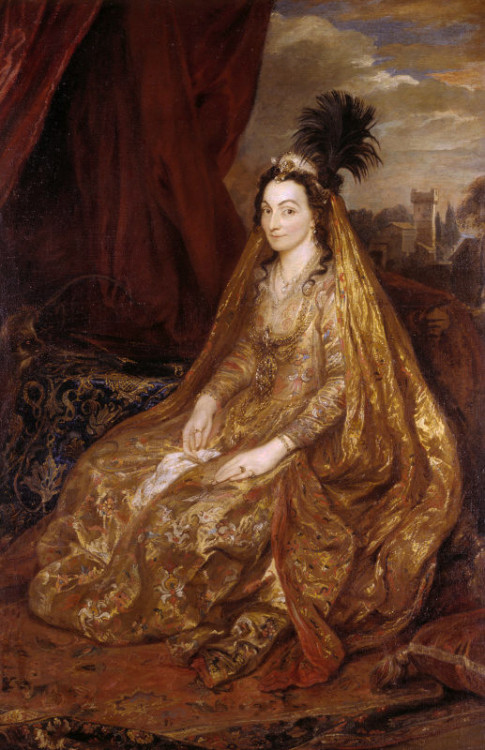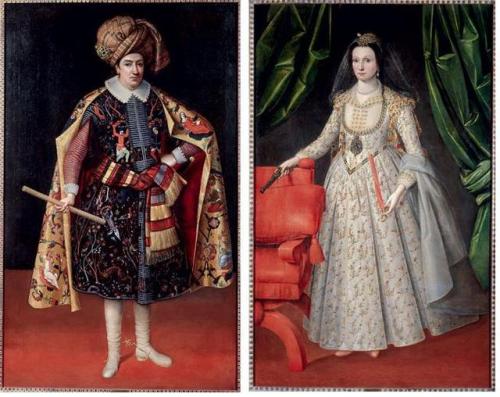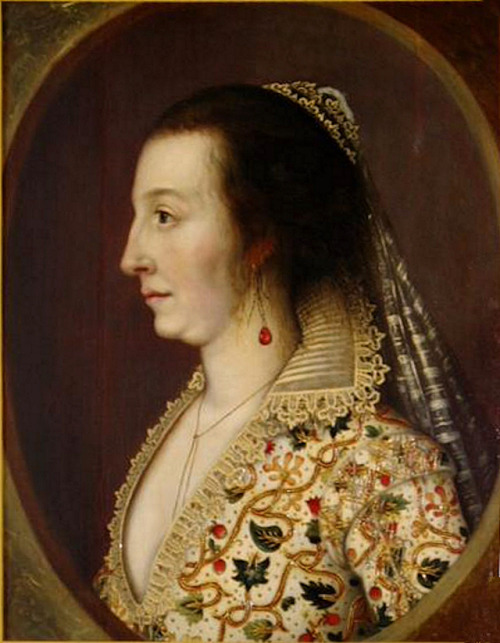1. Lady Shirley as painted by Anthony van Dyck in Rome, 1622 2. Portraits of Robert Shirley and Tere
1. Lady Shirley as painted by Anthony van Dyck in Rome, 1622 2. Portraits of Robert Shirley and Teresa Sampsonia, c. 1624–1627. Shirley is wearing Persian clothing; Teresa is in the European (English) fashion of the day, and holds a jewelled flintlock pistol in her right hand and a watch in her left. Teresa’s veil and jewelled crown are a variation on the headdresses worn by Iranian women from Isfahan in the first quarter of the seventeenth century.3. Lady Teresa Shirley, painted c. 1611–1613 by William Larkin in England, and dressed in then contemporary attire. According to art historian Patricia Smyth, “the embroidery on Teresa’s dress includes honeysuckles, which are to signify love, as well as strawberries, as a symbol for fruitfulness”. Smyth notes that these emblems may have an additional meaning “as the Shirley’s child, Henry, was born during this short stay in England”(Although the 2nd and 3rd images say she’s in English attire, I have to point out that those plunging necklines are unusual for the English, and I imagine they’re probably a Persian (Iranian) touch to the usual English gown.)Teresa Sampsonia (born Sampsonia; after marriage Lady Teresa Sampsonia Shirley, 1589–1668) was a noblewoman of the Safavid Empire of Iran. She was the wife of Elizabethan English adventurer Robert Shirley, whom she accompanied on his travels and embassies across Europe in the name of the Safavid King (Shah) Abbas the Great (r. 1588–1629).Thanks to her exploits, Teresa has been described as someone who subverted patriarchal gender roles common to the Muslim and Christian cultures of her time. Teresa was born in 1589 into a noble Orthodox Christian Circassian family in the Safavid Empire, ruled at the time by King Abbas the Great. She was named Sampsonia at birth. The daughter of Ismail Khan, a brother-in-law of the King, she grew up in Isfahan in the Iranian royal court as a reportedly beautiful, accomplished horsewoman who enjoyed embroidery and painting.Robert Shirley was an English adventurer who was sent to the Safavids, after a Persian embassy was sent to Europe, to forge an alliance against the neighbouring Ottoman Empire, rivals of the Safavids. During his attendance at court, Teresa met him and fell in love. On 2 February 1608, with the approval of her aunt and Abbas, Teresa married Robert Shirley in Iran. At about the time of their wedding, she was baptised as a Roman Catholic by the Carmelites in Isfahan with the name Teresa.Teresa accompanied Robert on his diplomatic missions for King Abbas to England and other royal houses in Europe. When they set off on their first embassy trip, Robert was captured by his enemies. Teresa reportedly managed to save him and put to flight the attackers; for this, the Carmelite records praised her as “a true Amazon”.Their only child, a son named Henry, in all likelihood the first English-born child of Iranian descent according to Sheila R. Canby, was born in November 1611 at the Shirley home in Sussex.Teresa was with her husband in Persia when Shirley died in dysentery. Teresa was then in some danger, especially as members of the court put about rumors that she had been Muslim before her conversion to Catholicism (she had actually been Orthodox Christian). Her belongings were plundered and her life threatened by some members of the court. She was repeatedly questioned about her religion and threatened with death and torture, but remained staunch in her beliefs. The Carmelites in Isfahan eventually won permission from the governor of Shiraz in September 1629 for Teresa to leave Persia. She never returned to the land of her birth.Teresa lived in Constantinople for three years, but eventually decided to retire to a convent in Rome, which was attached to the Carmelite Santa Maria della Scala church.On 27 December 1634 she arrived in Rome and was received kindly by Pope Urban VIII, who entrusted her to the Carmelites. Teresa bought a house next to the church. In 1658 she had Robert’s remains transported from Isfahan to Rome, where he was reburied in the Santa Maria della Scala. In the Carmelite convent, she devoted herself to charity and religion until her death at age 79 in 1668. Teresa was buried in the church, where she had lived for forty years, in the same grave where she had buried her husband Robert ten years earlier. She had the headstone inscribed (in Latin):“To God, the Best and Greatest. For Robert Sherley, most noble Englishman, Count Palatine, Knight of the Golden Spur, Emperor Rudolph II’s envoy to Shah Abbas, the King of Persia, (and) the representative of the same King to the Popes of Rome, to Emperors, to the Kings of Spain, England, Poland, Muscovy, and the Mogul Empire, distinguished ambassador to other European princes. Theresia Sampsonia, native of the land of the Amazons, daughter of Samphuffus, prince of Circassia, set up [this monument] for her most beloved husband and for herself, as a resting place for his bones—brought to Rome from Persia for dutiful devotion’s sake—and for her own, aged seventy-nine. 1668.” -- source link
#teresa sampsonia#persia#persian fashion#circassians#circassian fashion#georgia#georgian fashion#caucasia#caucasian fashion#17th century#renaissance#renaissance fashion


